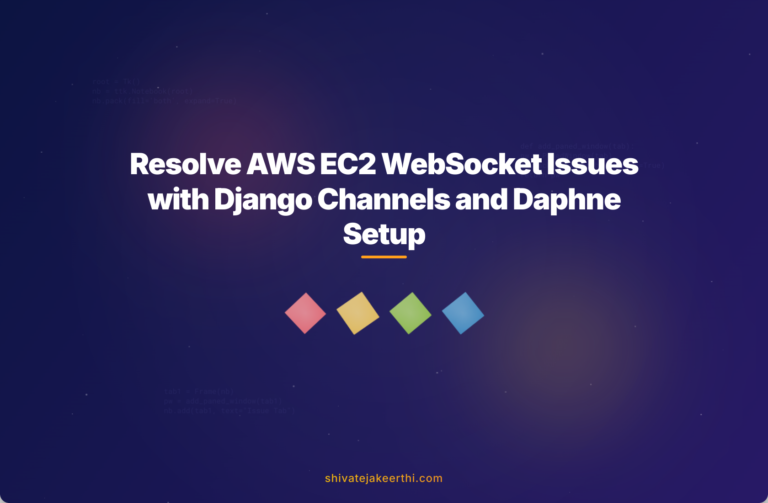When you’re building a real-time web application, WebSocket servers provide an efficient two-way communication pipeline between clients and your backend. One common stack many developers prefer involves Django Channels with the lightweight and efficient daphne server. But if you’ve spun up a WebSocket server on an AWS EC2 instance, you might encounter the pesky issue where your WebSocket connection works perfectly only locally but completely fails when accessed externally.
Essentially, your setup might work flawlessly when you test it directly from your EC2 instance using localhost or 127.0.0.1, but once you try to connect from your browser back on your local machine or elsewhere, you can’t establish a connection. So, how can you resolve this and make your AWS-hosted WebSocket server accessible from external endpoints? Let’s find out.
Troubleshooting AWS EC2 Security Group Settings
Before diving into your WebSocket server configuration, start by carefully examining your AWS EC2 instance’s security group. Think of it as the bouncer at a private event—if your port isn’t on the guest list, no data packets can pass through.
First, ensure you’ve explicitly allowed traffic for the particular port your WebSocket server uses (commonly port 8001). The easiest way to do this is by visiting your EC2 Security Groups section in the AWS console, then reviewing your inbound and outbound rules. If your port isn’t explicitly listed there, add it immediately.
Here’s an example configuration:
- Inbound rules should allow TCP port 8001 from source “Anywhere” (0.0.0.0/0).
- Outbound rules typically allow all outgoing traffic, so no additional configuration is usually required here.
Double-check these rules, as they’re often the biggest reason WebSockets fail externally. Also, avoid overly broad settings—stick to the ports and protocols you need, limiting potential vulnerabilities.
Verifying Your WebSocket Server Configuration
After confirming your security group is configured correctly, ensure your WebSocket server doesn’t have internal restrictions preventing external connections. Many frameworks (Django Channels included) run in local-only mode by default for security reasons—accepting connections only from localhost.
Check your startup command or the Daphne server invocation. Often you’ll need to explicitly instruct your WebSocket server to listen on all external interfaces. For example, instead of running:
daphne myproject.asgi:applicationExplicitly bind your server to the correct network interface like this:
daphne -b 0.0.0.0 -p 8001 myproject.asgi:applicationHere the important part is the ‘-b 0.0.0.0’, which tells the server it should listen on all available external interfaces, allowing external users to reach the WebSocket server.
Additionally, double-check your configuration files, such as Django or ASGI settings, to ensure there aren’t restrictions or settings limiting IP ranges or external access.
Investigating Potential Network Issues Within AWS
Even if your security groups look correct, another layer of networking may cause external connection issues. AWS EC2 uses both security groups and network ACLs (Access Control Lists) at the subnet level. If your WebSocket server lives within a restrictive subnet ACL, external connections might still fail silently.
To troubleshoot this:
- Head to your AWS VPC dashboard and confirm your subnet and ACL rules allow connections to port 8001.
- Use simple networking tools like netcat or telnet from another machine to verify network reachability.
For example, run the following from a terminal on your local machine (replace “your_ec2_ip” with your actual EC2 instance IP):
nc -vz your_ec2_ip 8001If netcat can’t reach your IP port combination, re-verifying network ACL settings and security group configurations would be your next step.
Configuring External Access in Your WebSocket Server
Once you’re sure your AWS and networking settings look good, focus specifically on your server code. Django Channels with Daphne must explicitly allow access from external IP addresses.
In your Django settings file (usually settings.py), ensure your ALLOWED_HOSTS includes your EC2 public DNS or IP address:
ALLOWED_HOSTS = ['your.ec2.domain.com', 'X.X.X.X']Also, verify your frontend client JavaScript connects to the correct external IP/domain and port explicitly. For example, your JS WebSocket initialization should look like this:
let websocket = new WebSocket('ws://your.ec2.domain.com:8001/ws/socket-path/');Ensure your paths match the routing set up in Django Channels properly.
Testing External Connection and Troubleshooting
Try connecting from an external browser or use simple online tools like websocket.org Echo Test page to check connectivity quickly. If you receive connection errors at this point, enable detailed Django logging to check internal errors.
In settings.py, adding clear error logging can pinpoint problems:
LOGGING = {
'version': 1,
'disable_existing_loggers': False,
'handlers': {
'console': {
'class': 'logging.StreamHandler',
},
},
'loggers': {
'django.channels': {
'handlers': ['console'],
'level': 'INFO',
},
},
}Additional Tips and Common Pitfalls
Some subtle problems often emerge when dealing with WebSockets in production environments:
- SSL/TLS: Modern browsers expect WebSockets to run over secure WSS:// protocol, especially when your main site runs HTTPS. Set up SSL certificates properly to meet security standards.
- Proxy servers: Load balancers or reverse proxies (like Nginx) often interrupt WebSockets. Configure proxy headers (more details on Python category) correctly to retain connection upgrades properly.
- Authentication: Always protect your WebSocket endpoints. Django Channels provides powerful authentication mechanisms—use them to prevent unauthorized access.
Best Practices for Optimizing & Securing Your WebSockets
Once you’ve resolved connection issues, boost security and performance further:
- Implement proper message throttling and rate-limiting to prevent DoS attacks.
- Validate all inbound messages on the server to ensure client integrity.
- Use load balancing strategies for large-scale production deployments to maintain responsiveness and reliability.
AWS-level tools like CloudWatch logs and metrics can help by offering real-time monitoring and insights into connection counts and usage.
Resolving the issue of AWS EC2 WebSocket servers not connecting externally usually boils down to methodically checking security groups, server configuration settings, networking ACLs, and finally, your Django Channels and codebases. Following these troubleshooting steps carefully will bring clarity and success to your deployment.
Have you encountered other interesting AWS or WebSocket issues recently? Let us know in the comments, or explore other helpful resources and tutorials on AWS and Python stacks. Happy coding!



0 Comments